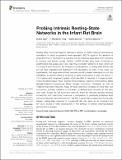| dc.contributor.author | Bajic, Dusica | en_US |
| dc.contributor.author | Craig, Michael M. | en_US |
| dc.contributor.author | Borsook, David | en_US |
| dc.contributor.author | Becerra, Lino | en_US |
| dc.date.accessioned | 2016-12-02T15:24:20Z | |
| dc.date.issued | 2016 | en_US |
| dc.identifier.citation | Bajic, Dusica, Michael M. Craig, David Borsook, and Lino Becerra. 2016. “Probing Intrinsic Resting-State Networks in the Infant Rat Brain.” Frontiers in Behavioral Neuroscience 10 (1): 192. doi:10.3389/fnbeh.2016.00192. http://dx.doi.org/10.3389/fnbeh.2016.00192. | en |
| dc.identifier.issn | 1662-5153 | en |
| dc.identifier.uri | http://nrs.harvard.edu/urn-3:HUL.InstRepos:29626004 | |
| dc.description.abstract | Resting-state functional magnetic resonance imaging (rs-fMRI) measures spontaneous fluctuations in blood oxygenation level-dependent (BOLD) signal in the absence of external stimuli. It has become a powerful tool for mapping large-scale brain networks in humans and animal models. Several rs-fMRI studies have been conducted in anesthetized and awake adult rats, reporting consistent patterns of brain activity at the systems level. However, the evolution to adult patterns of resting-state activity has not yet been evaluated and quantified in the developing rat brain. In this study, we hypothesized that large-scale intrinsic networks would be easily detectable but not fully established as specific patterns of activity in lightly anesthetized 2-week-old rats (N = 11). Independent component analysis (ICA) identified 8 networks in 2-week-old-rats. These included Default mode, Sensory (Exteroceptive), Salience (Interoceptive), Basal Ganglia-Thalamic-Hippocampal, Basal Ganglia, Autonomic, Cerebellar, as well as Thalamic-Brainstem networks. Many of these networks consisted of more than one component, possibly indicative of immature, underdeveloped networks at this early time point. Except for the Autonomic network, infant rat networks showed reduced connectivity with subcortical structures in comparison to previously published adult networks. Reported slow fluctuations in the BOLD signal that correspond to functionally relevant resting-state networks in 2-week-old rats can serve as an important tool for future studies of brain development in the settings of different pharmacological applications or disease. | en |
| dc.language.iso | en_US | en |
| dc.publisher | Frontiers Media S.A. | en |
| dc.relation.isversionof | doi:10.3389/fnbeh.2016.00192 | en |
| dc.relation.hasversion | http://www.ncbi.nlm.nih.gov/pmc/articles/PMC5067436/pdf/ | en |
| dash.license | LAA | en_US |
| dc.subject | blood oxygen level-dependent | en |
| dc.subject | BOLD | en |
| dc.subject | fMRI | en |
| dc.subject | MRI | en |
| dc.subject | rs-fMRI | en |
| dc.subject | neurodevelopment | en |
| dc.subject | neuroimaging | en |
| dc.title | Probing Intrinsic Resting-State Networks in the Infant Rat Brain | en |
| dc.type | Journal Article | en_US |
| dc.description.version | Version of Record | en |
| dc.relation.journal | Frontiers in Behavioral Neuroscience | en |
| dash.depositing.author | Bajic, Dusica | en_US |
| dc.date.available | 2016-12-02T15:24:20Z | |
| dc.identifier.doi | 10.3389/fnbeh.2016.00192 | * |
| dash.contributor.affiliated | Bajic, Dusica | |
| dash.contributor.affiliated | Becerra, Lino | |
| dash.contributor.affiliated | Borsook, David | |


